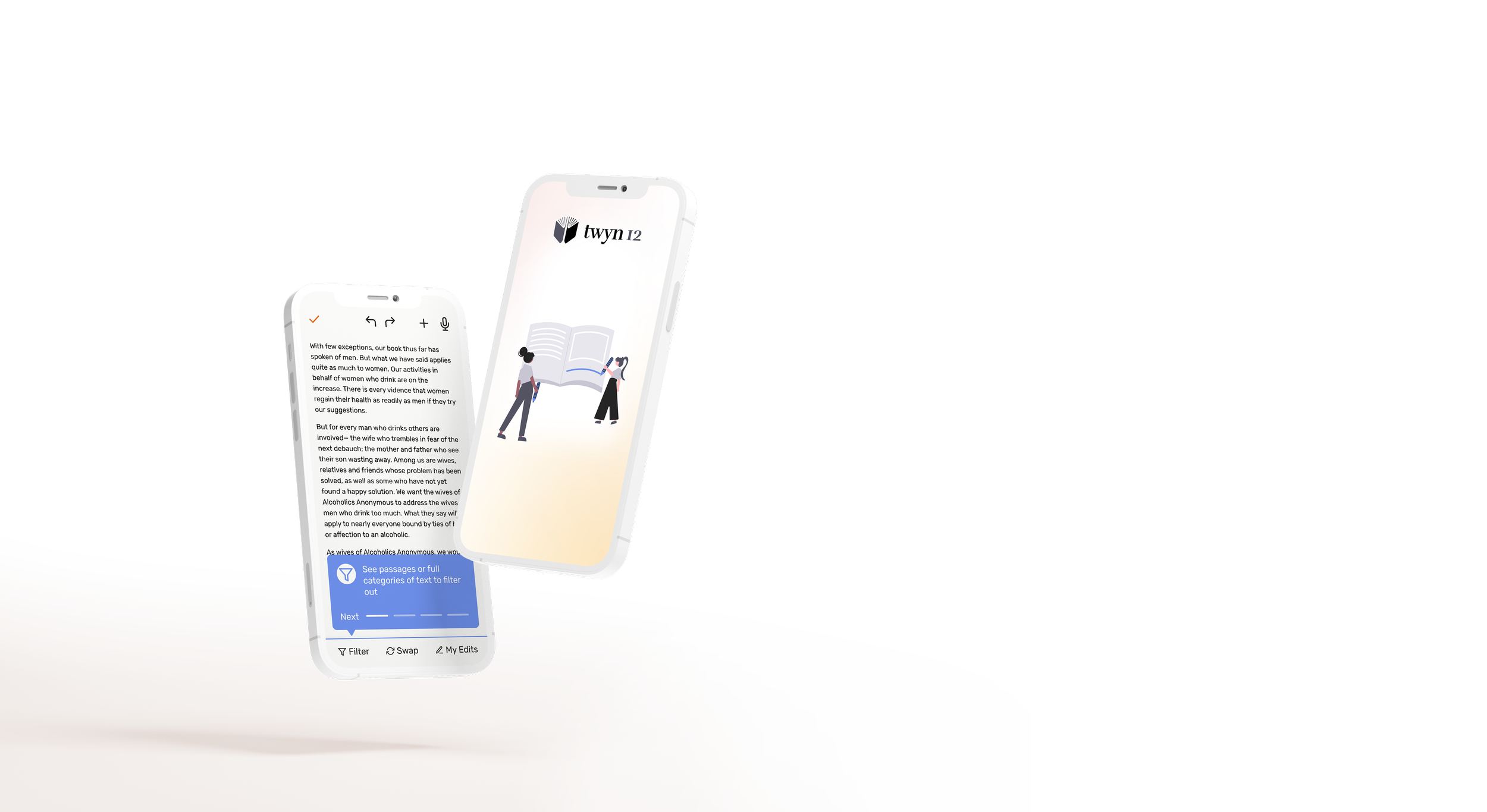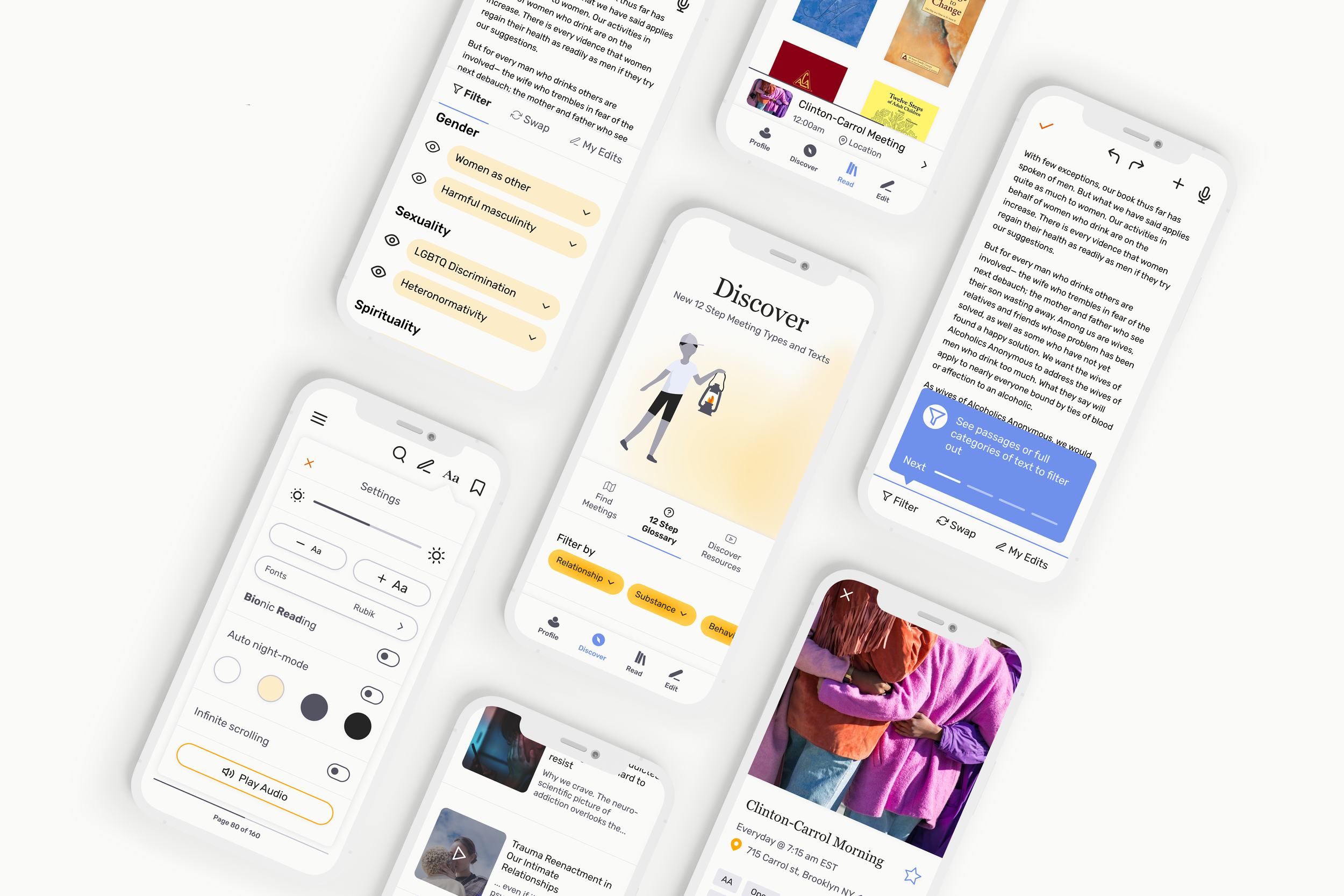
End to end application design
twyn12
An application that aims to empower its 12-step users by offering them more control and autonomy over their meeting experience and literature

TWYN 12
Take What You Need
Find meetings
Find text
Change text
Process
-
Qualitative interviews with 7 twelve step members
Affinity mapping to find pain points
Persona creation to ground design decisions
Competitive research to find holes or need in the market
-
Conducted card sorting tests to determine where information is stored
Site maps to create a blueprint for wire framing
-
Story boarding to determine how this product would situate itself in the environment and with the user
Created user and task flows to build the foundation for wireframing
-
Low/mid/high fidelity wire-framing
Rapid iterations based on feedback
Prototyping full interactive experience
-
Conducted usability tests at mid and hi fidelity wire framing stages
Created full research plan, tasks and scripts
Conducted usability tests with 5 participants
Affinity mapped pain points
Determined areas with the most needs
-
Iterated design at medium and high fidelity stages
Used user feedback to form final experience
Was able to preemptively find and resolve pain points
-
Created branding and logo designs guidelines based on company values
Conducted testing with users to determine style, font, and color scheme
Produced and maintained full design system with component library
Project by Shona O’Bryant
Created in 2022
Software used: Figma, fig jam, zoom, google suite
Skills used: System design, UI/UX Design, Branding Design and UX Research
The 12 step model was developed in 1935
And modern meetings use virtually the same text as the beginning. Many 12 Step literature contains artifacts of their time that can have alienating or detrimental effects that interferes in finding sobriety and healing.
So the language is outdated. How did I find this out?
By listening to 12 step participants directly. I held qualitative interviews with
7
Participants
8
Different types of twelve step groups
3
Personas created based on feedback and varied age, demographic, experience in 12 step programs, etc
5.4
Hours of interviews
Don’t believe me? Here is a user quote that describes the issue better than I can
"The [AA] book is completely inappropriate to be reading today. The [AA] big book is unacceptable… It all needs to be more radically accepting"
If users are leaving because of the language, then how might we
Empower 12 step individuals to bring their meeting into the future and feel comfortable in their space, content and community?
A Solution: An application that allows the user to change text
The bones of a 12 step meeting is what is read during those meetings. If the user can change the text, they can change their meeting. If they can change their meeting, that may increase their chance of retention.
The editing page progression from low to med to high fidelity wireframes
How it works
Find meetings and resources
Discover meetings, articles, resources and different twelve step programs
Filtering and map options to help the user find what they need, faster
Easily tell the “personality” of the meeting by custom tags based on the changes made to the literature
Example iterations based on usability tests: Adding a map function, adding extra contact info to meeting pages. Altering information architecture. Adding custom tags to tell the “personality of a meeting.”
How it works
Convenient access to text
All meeting text (what is used to hold meetings) is easily located on one page
Accessibility options for reading
Example iterations based on usability tests: Changing the position of the literature section on the meeting page to be more noticeable.
How it works
Easily make direct edits
Filter out language that could be exclusionary
Swap words that are repeated throughout the book
Make direct and customized edits to the text
Example iterations based on usability tests: the verbiage used, having the editing options visible instead of in a menu. Creating more instructions in the “my edits” section
How it works
Save edits publicly or privately
Ability to submit edits to be made to a meeting text
Ability to change the users personal copy
Example iterations based on usability tests: clarifying what happens when the user submits. Added the option to change personal text.
What was the response?
Please note that these responses were for the last round of usability testing. The prototype has since changed.
A quote from usability testing










